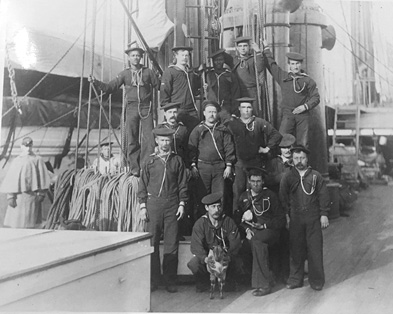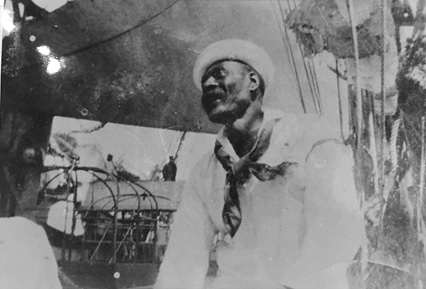The sea and ships offered black sailors working opportunities that were somewhat more reliable than the jobs offered on land. African American men held a disproportionate percentage of positions on sailing ships based on their percentage of the population in places like Providence, Rhode Island, New Bedford, Massachusetts, New York, and Philadelphia, Pennsylvania. Being a seamen offered opportunities for black men that they did not find in other types of work. For example, wages were higher aboard ship than the jobs that could be found on land. In addition, black seamen were paid on par with white seamen for doing the exact same job. It was the hierarchy of jobs that determined the pay, not the color of one’s skin. In addition to a wage, black seamen also had a modicum of status depending on his level of skill and experience on a ship.

Photo caption: The mizzen topmen on the bark Galena circa 1880-1892.
Ships ran on a “concept of order” (Bolster, Journal of American History, p. 1180) with a “priority on shipboard order maintained through precise distinction of role and status.” (Ibid, 1180) W. Jeffrey Bolster points out that, “For a black man then, the ship provided a unique workplace where his color might be less a determinant of his daily life and duties than elsewhere.” This was particularly important to black men who had escaped slavery. They could experience something close to equity in their jobs and lives. Of course this not to say that the black seaman did not face adversity. Sailing was a difficult profession. The work was hard and the hours long. There was the possibility of injury. There was the danger of a ship foundering and sinking. The issues of race still existed but they were somewhat modified on board ship.
African American seamen served as conduits of communication for their communities and between communities. Traveling to different ports allowed them to share information and ideas. This was a particular concern for southern white slaveholders following the failure of the Charleston, South Carolina slave uprising in 1822 planned by Denmark Vesey (and Peter Poyas). The result of this failed uprising was the creation on the Negro Seamen Act. It says in part:
“According to the statute, county sheriffs henceforth were obliged to arrest all “colored” sailors, regardless of nationality, until their ship was ready to leave harbor. The captain of the vessel was monetarily responsible for a bond to cover the expenses of their incarceration. If the captain refused to pay, he was “liable to be indicted, and, on conviction…be fined in a sum not less than one thousand dollars, and imprisoned not less than two months.” If this penance seemed a touch harsh, it paled in comparison to the one doled out to the sailors of the recalcitrant captain, as “such negroes or persons of color shall be deemed and taken as absolute slaves, and sold.” Essentially free black men could be sold as slaves. (Navigating The Dangerous Atlantic: Racial Quarantines, Black Sailors And United States Constitutionalism, pg. 36 Michael Alan Schoeppner)
This legislation, although initially brought to bear in South Carolina, was eventually enacted in other southern states, with Louisiana being the last to bring such legislation. Early on, African American sailors did not think that the law would be enforced with much vigor. But South Carolina did indeed enforce the law which served not only to restrict the movements of black sailors and task them with demeaning work while incarcerated, but it also restricted their means of income. African American sailors had to pay back the expenses of their incarceration. Once incarcerated, black sailors were warned not to come back to the state. If they returned they were subject to the whip.
Even with these stringent laws, African American sailors initially continued to sail to southern ports but as southern states became more intent on enforcing these laws, the number of black sailors arriving at these ports diminished. Even so, this did not keep slaves from seeking freedom via the sea.

Photo caption: Seaman Sam Tines of the bark Monongahela circa 1899.
Slaves used the skills they already had or that they acquired aboard ship to aid them in their escape. The fact that black sailors were not an uncommon sight allowed escaping slaves to blend in easily. Also, the use of sailor’s protection papers was an important vehicle of escape. Black sailors both strengthened and connected their communities. They became leaders and abolitionists. The wages that they earned helped build their families and their support systems. Their ability to travel, sometimes great distances, from one community to the next provided the opportunity to share information and ideas. The sea was indeed an escape route and it was also a way of life for many African American men.
Dorothea Crosbie-Taylor has been a Park Guide with San Francisco Maritime National Historical Park for 1 ½ years. She has her Master’s Degree in Public History and is interested in women’s and people of color’s contributions to Maritime history.
